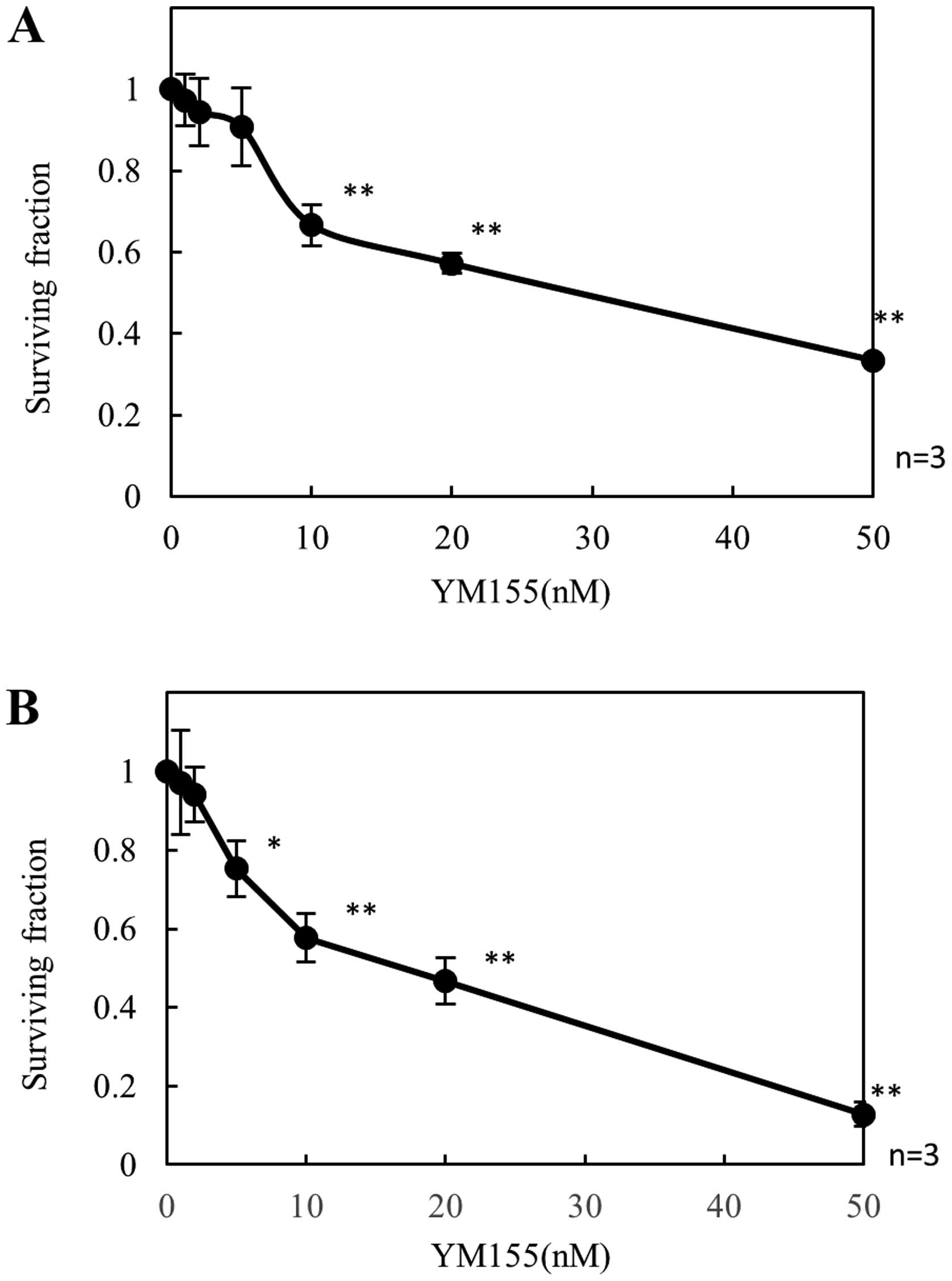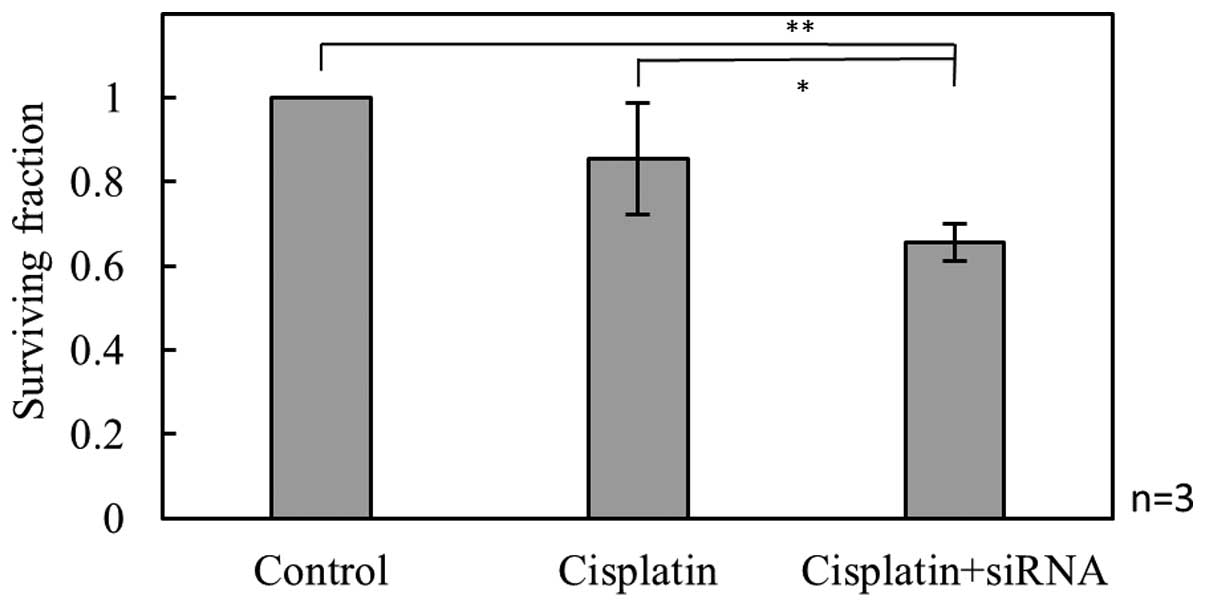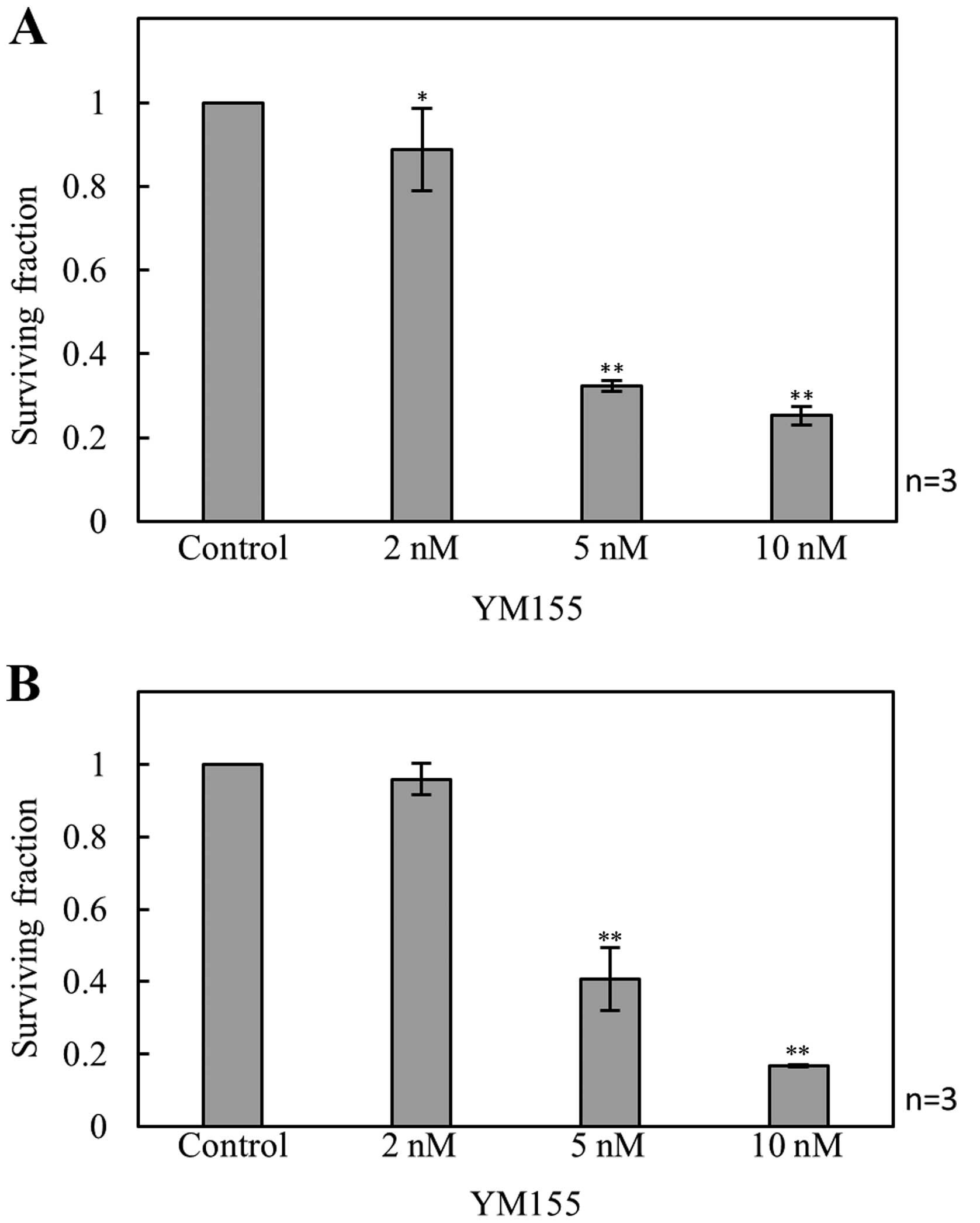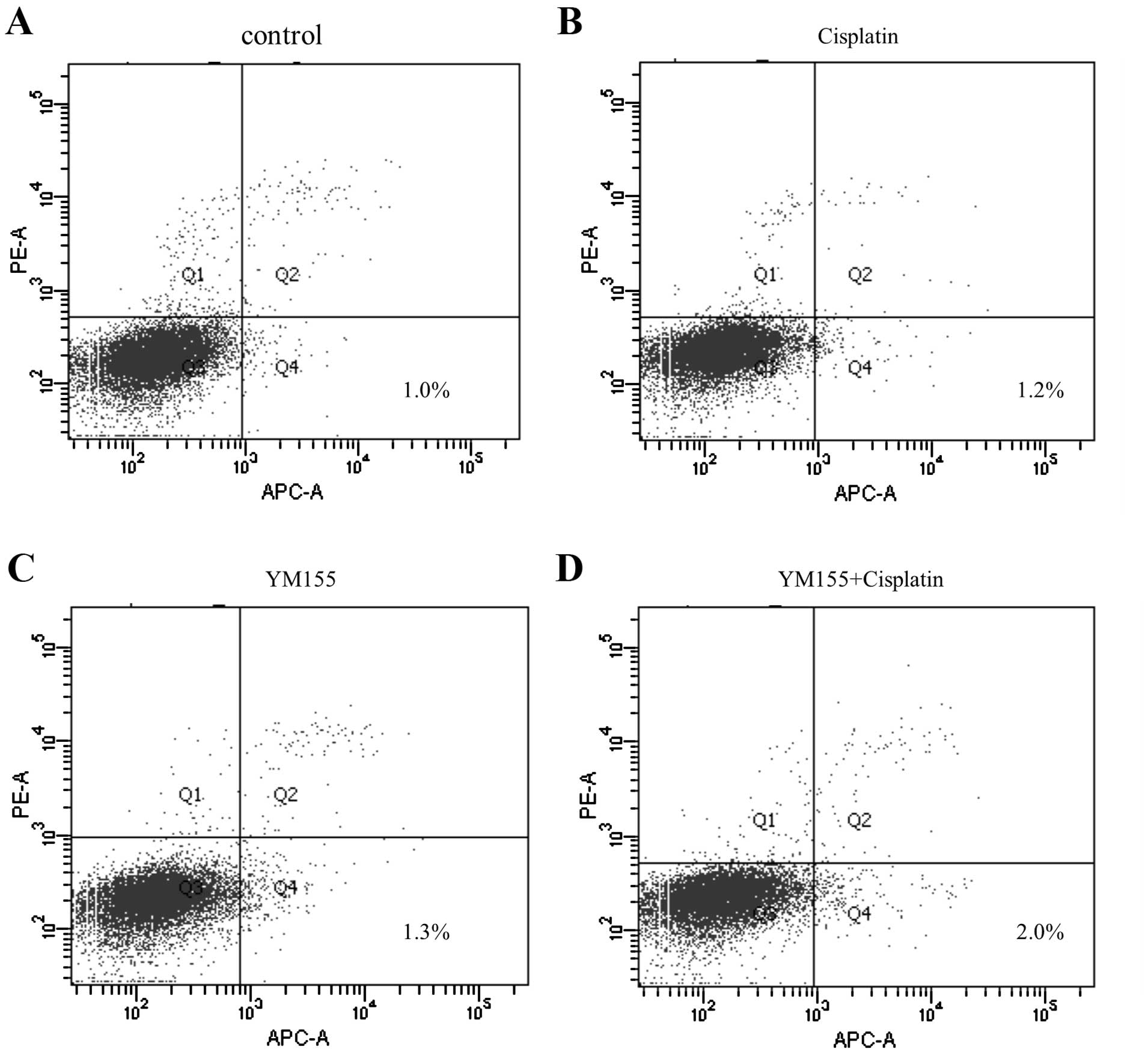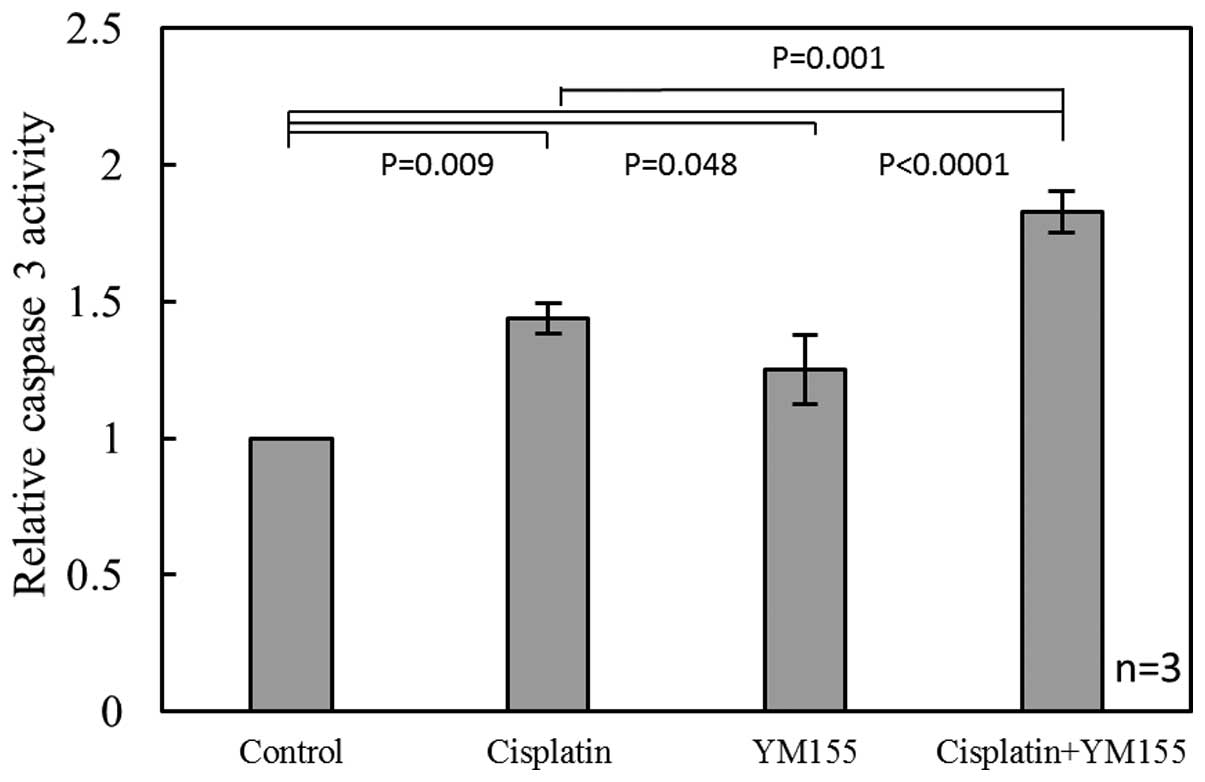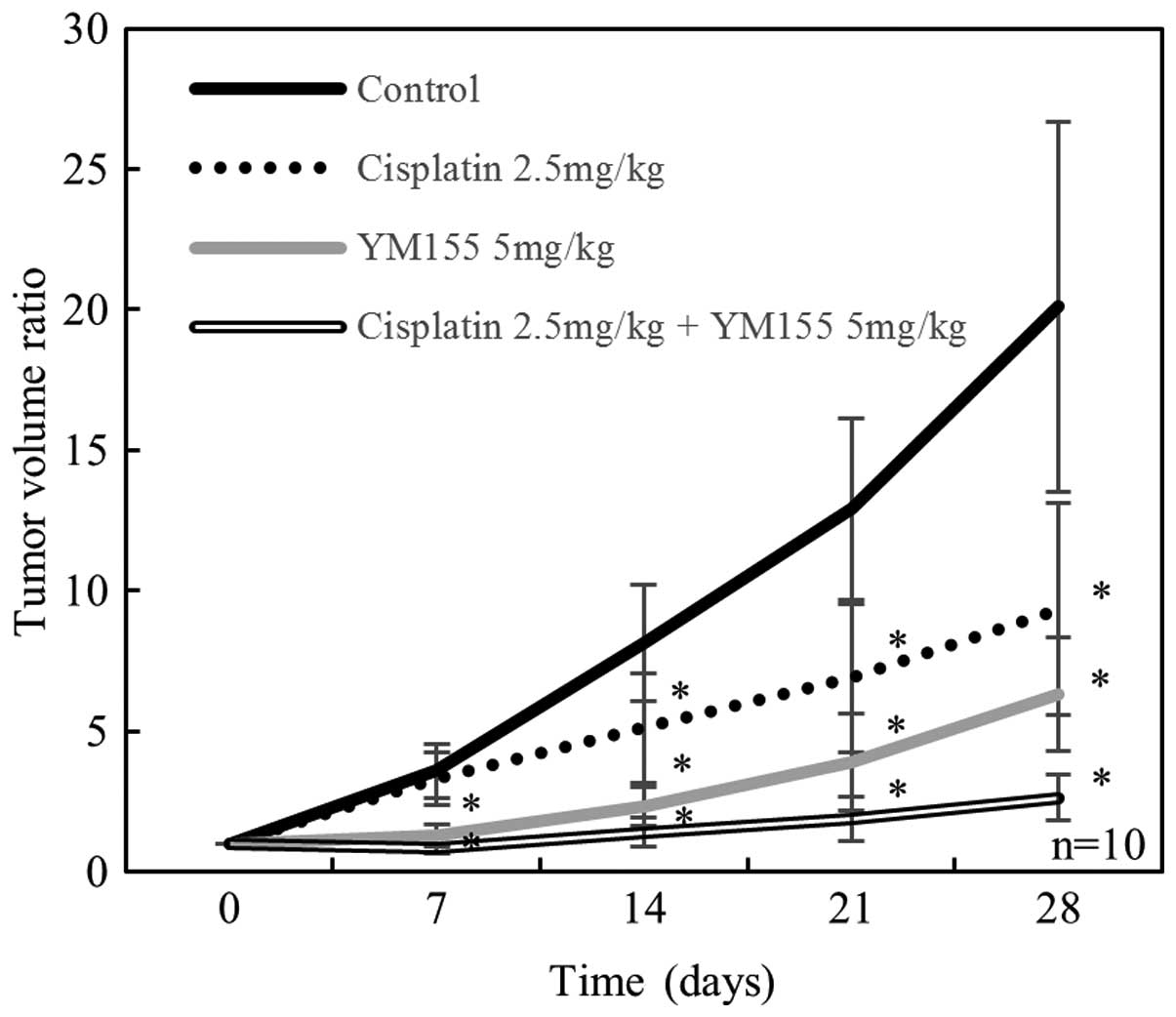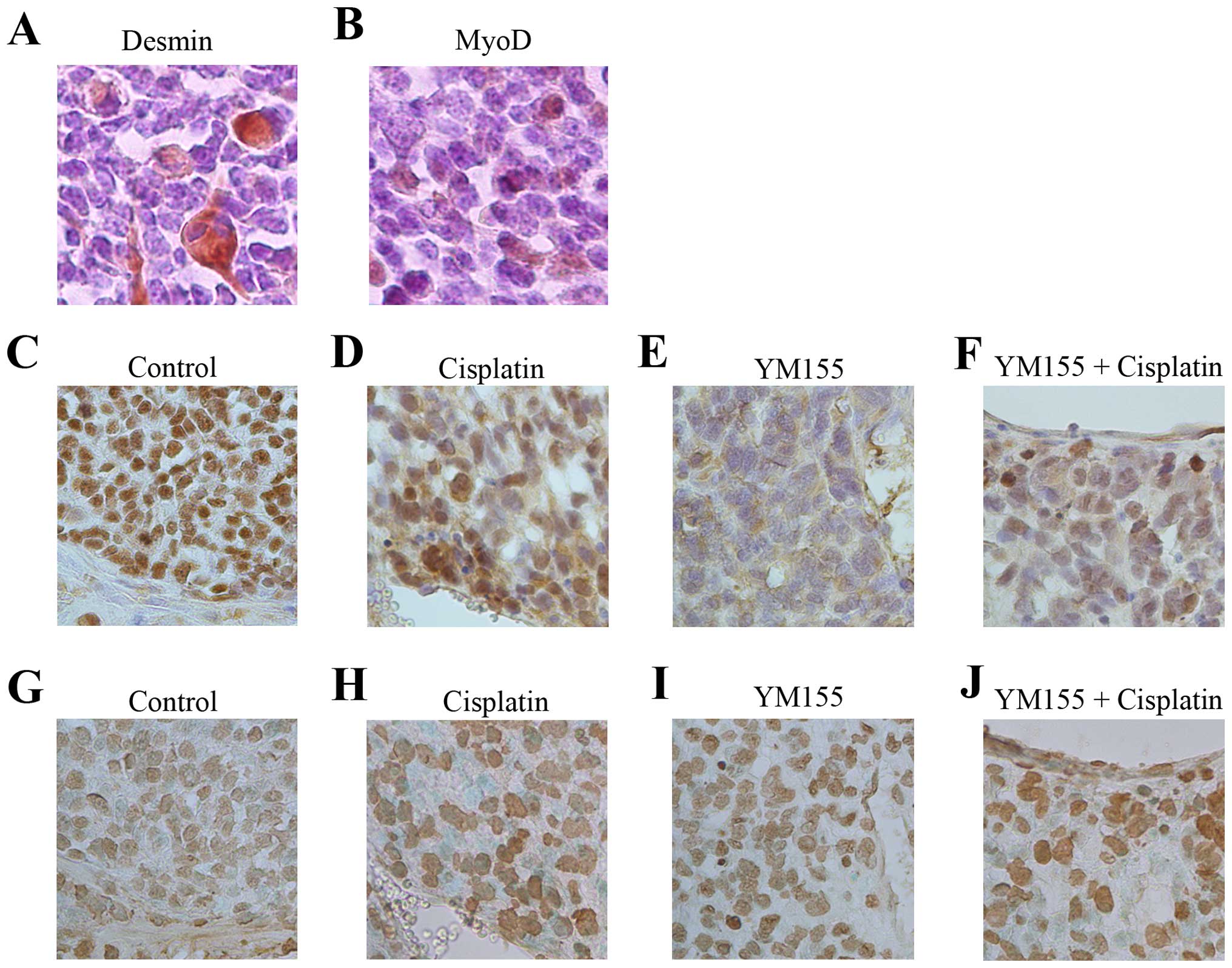Introduction
Rhabdomyosarcoma (RMS) is the most common soft
tissue sarcoma in children, the incidence of RMS in children <20
years old is 4.3 per million per year (1). Current treatment for RMS relies on
chemotherapy, along with surgery and radiotherapy. The prognosis
for non-metastatic RMS has improved considerably over the last
30–40 years due to use of combination chemotherapy (2–4).
Despite significant improvements in survival over the past few
decades, more than one-third of RMS patients continue to die of the
disease (5). In particular, the
outcomes of patients with metastatic disease remain very poor,
despite intensification of treatment with agents known to be active
and attempts at introducing novel therapies (6–8). The
mainstay of chemotherapy for RMS continues to be vincristine and
actinomycin D in combination with cyclophosphamide, so-called VAC
treatment. The most recent Children's Oncology Group (COG) trial
for low-risk RMS showed that patients have an excellent outcome
[2-year event-free survival (EFS), 88%; overall survival (OS), 98%]
with short therapy duration (9).
Whereas the most recent COG high-risk RMS study showed poor outcome
in 3-year EFS 38% (10).
Other drugs such as doxorubicin, etoposide, and
cisplatin have been added to this combination in higher risk
patients, but to date there is no definitive proof of improved
outcomes with the addition of these drugs, despite evidence of
response in the relapse setting (6).
Survivin is a 16.5-kDa member of the inhibitor of
apoptosis protein family, and blocks the mitochondrial pathway of
apoptosis by inhibiting caspases (11). Survivin is not expressed in
differentiated normal tissue (12,13).
Higher survivin expression has been correlated with unfavorable
survival or disease recurrence in various adult malignancies
(12,14–22).
In the pediatric setting, most primary hepatoblastoma tissue
specimens express survivin, and its expression was shown to
increase after chemotherapy, suggesting that survivin may play a
role in the survival of tumor cells (23). Survivin has therefore become a
therapeutic target of pediatric tumors.
YM155 is a novel, small, imidazolium-based compound
that specifically inhibits survivin, as determined using a survivin
promoter activity assay (24). In
pre-clinical experiments, YM155 as a single agent downregulated the
transcription of survivin in a dose/time-dependent manner,
triggering p53-independent apoptosis in a wide range of human tumor
cells. YM155 also induced tumor regression in established cancer
xenografts (24,25), and the combination of YM155 with
various chemotherapeutic agents potentiated apoptosis induction in
several human cancers (26–28).
Despite its demonstrated efficacy in targeting tumor cells, the
effects of YM155 in combination with DNA-damaging drugs have
remained largely unknown.
Once primary chemotherapy fails, cancer cells became
resistance to the drug. We used a cell line that was treated by
cyclophosphamide, therefore other DNA-damaging drugs should be
explored (29).
The platinum compound cisplatin, DNA damaging drug,
showed efficacy combined with YM155 in previous reports (28,30,31).
In this study, we selected cisplatin combined with YM155 to search
for a new regimen. We examined the effects of YM155 in combination
with the platinum compound cisplatin on a human RMS cell line both
in vitro and in vivo. Given the importance of
survivin in cisplatin apoptosis resistance, and with the aim of
finding new strategies to reduce cisplatin doses in patients with
RMS, we sought to determine whether YM155 synergized with cisplatin
to affect the RMS cell line in vitro, and as a tumor
xenograft.
Materials and methods
Cell culture
Cells from the human rhabdomyosarcoma cell line RD
were obtained from Japanese Collection of Research Bioresources
Cell Bank. Cells were maintained in Gibco RPMI-1640 (Thermo Fisher
Scienrific, Waltham, MA, USA), supplemented with 10%
heat-inactivated fetal bovine serum in a humidified incubator with
5% CO2 at 37°C.
Reagents
YM155 was purchased from Selleck Chemicals (Houston,
TX, USA) and dissolved with DMSA to a final stock solution
concentration of 1 mM cisplatin (Wako Pure Chemical Industries,
Osaka, Japan) was dissolved in sterile water to a final stock
solution concentration of 1 mM.
Real-time PCR
RD cells were cultured in medium with or without
various concentrations of YM155 and/or cisplatin. Control cultures
received dimethyl sulfoxide 0.1%. For RNA extraction, NucleoSpin
RNA (Takara, Osaka, Japan) was used according to the manufacturer's
protocol. Primix Taq (Takara) was used for the reaction. The
primers to detect human Survivin (Invitrogen, Carlsbad, CA, USA)
used for PCR were as follows: 5′-GGCTCTTTCTCTGTCCAGTT-3′ (forward),
5′-ACCACCGCATCTCTACATTC-3′ (reverse). Equal volumes of PCR products
were electrophoresed through agarose gel in TBE buffer.
Quantitative PCR
Custom primers to detect human survivin and
glyceraldehyde 3-phosphate dehydrogenase (GAPDH) were created by
Invitrogen. Sybergreen analysis was carried out with SYBR Premix Ex
Taq II (Takara). Quantitative PCR was performed using an Applied
Biosystems ViiA 7 System (Thermo Fisher). Results from each sample
were compared using the comparative CT method (Applied Biosystems).
Genomic levels and cDNA expression levels were measured relative to
GAPDH. Experiments were performed in triplicate.
Western blot analysis
Protein was extracted by western blot assays.
Extracted protein samples were resolved by SDS-PAGE and transferred
to a polyvinylidene difluoride membrane. After blocking at room
temperature with TBS-T buffer, each membrane was incubated for 1 h
at 4°C with the primary antibodies anti-survivin (Cell Signaling,
Beverly, MA, USA) and mouse anti-β-actin (Cell Signaling). The
membranes were then washed with TBS-T and incubated with
horseradish peroxidase-conjugated secondary antibody for 1 h at
room temperature. Immunostar Zeta (Wako Pure Chemical Industries)
was used as luminescence solution. Proteins of interest were
visualized using the ImageQuant LAS 4000 Mini (General Electric
Co., Fairfield, CT, USA).
RNA interference
Validated human anti-survivin siRNA was purchased
from Life Technologies Corp. (Carlsbad, CA, USA). A control
scramble (nonsilencing) siRNA was purchased from Cell Signaling
Technology. Cells were seeded at 24 h before transfection with
either anti-survivin siRNA or control scramble siRNA using the
Lipofectamine RNAiMAX Transfection reagent (Life Technologies
Corp.). The final concentration of siRNA duplex in the culture
medium was 50 nmol/l.
Cell growth inhibition assay
The RD cell lines were used to determine the
inhibitory effect of YM155 on cell growth by the WST assay, which
uses the highly water-soluble tetrazolium salt WST-8. Cells
(6×104/well) were plated in 96-well plates and then
cultured in medium with or without various concentrations of YM155
and/or cisplatin. Control cultures received 0.1% DMSO. At 24 and 48
h, after the treatment, the percentage of viable cells in each well
was examined with a Cell Counting Kit-8 (Dojindo Molecular
Technologies, Kumamoto, Japan) using a Multiscan Go microplate
multi-spectrophotometer (Thermo Fisher Scientific).
Annexin V assays
Annexin V/propidium iodide staining was carried out
using a BD Annexin-V kit (BD Biosciences, Franklin Lakes, NJ, USA),
and analyzed by FACS in a BD FACS Canto II flow cytometer (BD
Biosciences).
Assay of caspase-3 activity
Sixty thousand cells from each experimental
condition were assayed for caspase-3 activity using the Apo-ONE
Homogeneous Caspase-3/7 assay (Promega, Madison, WI, USA). This
system uses the profluorescent substrate rhodamine 110
bis-(N-CBZL-aspartyl-L-glutamyl-L-valyl-L-aspartic acid amide;
Z-DEVD-R110), which allows highly sensitive, quantitative
measurement of caspase-3 protease activity. Caspase activity,
measured with the SH-9000 microplate reader (Corona Electronic,
Hitachinaka, Japan), is indicated by intense rhodamine 110
fluorescence at 499 nm. The emission maximum is 521 nm. Experiments
were performed in triplicate.
In vivo antitumor activities in an RD
xenograft model
Four-week-old male mice (NOD SCID) were purchased
from Oriental Yeast (Tokyo, Japan). RD cells (2×106)
were injected into the backs of the mice. After tumors grew to
>20 mm in diameter, 5-mm cubic sections of tumor were
transplanted into the flank of 4-week-old male nude mice (BALB/c
nu/nu), purchased from Oriental Yeast. After tumor diameter reached
8 mm, 5 mg/kg of YM155 was administered intraperitoneally (i.p.)
once a day for 4 weeks. Cisplatin was administered i.p. at a dose
of 2.5 mg/kg twice a week. Tumor diameters were measured once a
week, and tumor volumes were determined (length ×
width2)/2. Observations continued until day 28 after
transplantation. The experiments were reviewed and approved by the
Animal Experimentation Committee of Osaka University (permit no.
25-058-000), and conducted in accordance with institutional
guidelines. All efforts were made to minimize suffering.
Immunochemistry
Tumors were harvested at the end of the experiments
(after 28 days) as fixed, paraffin wax-embedded sections. Sections
were subsequently dewaxed and rehydrated, and survivin expression
was determined by staining with survivin, desmin, and myoD
antibodies with the Real Envision detection system (Dako Denmark
A/S, Glostrup, Denmark). After specific staining or hematoxylin and
eosin staining, sections were dehydrated in alcohol and xylene and
subsequently mounted on a slide.
Apoptosis stain
Tumor sections were subjected to terminal
deoxynucleotidyl transferase dUTP-biotin nick end-labeling (TUNEL)
staining, performed with an In Situ Apoptosis Detection kit
(Takara) using anti-FITC horseradish peroxidase conjugate.
Statistical analysis
Results are expressed as relative change compared
with DMSO controls and are given as the mean ± SD. The statistical
differences between groups were tested using a two-tailed Student's
t-test. Statistical significance was assumed for P-values
<0.05.
Results
YM155 inhibits endogenous survivin
expression in RD cells and induces RMS cell apoptosis in vitro
Endogenous survivin mRNA expression in RD, an RMS
cell line, was significantly suppressed in a dose-dependent manner
by >10 nM YM155 in vitro, measured by quantitative PCR
(Fig. 1A). YM155 suppressed
survivin expression at concentrations of 5 nM and higher (Fig. 1B). These results suggested that the
suppression of survivin by YM155 occurs via the transcriptional
inhibition of the survivin gene. We also used western blotting to
confirm that YM155 suppressed survivin protein synthesis as well as
siRNA did (Fig. 1C).
To evaluate the ability of YM155 to induce cell
death in RD cells, we treated the cells with YM155 for 24 and 48 h,
after which cell viability was assessed with the WST-8 method.
YM155 concentrations from 1 to 50 nM significantly decreased the
viability of cells in a dose-dependent manner (Fig. 2).
Suppressing survivin mRNA expression by
siRNA or YM155 enhances cisplatin-induced apoptosis in vitro
RD cells were treated with cisplatin or the
combination of siRNA and cisplatin, and cell viability was then
assessed with the WST-8 method to assess the in vitro
effects on survivin mRNA suppression. Suppressing survivin mRNA
with siRNA significantly decreased the viability of cells,
suggesting enhancement of cisplatin-induced apoptosis in
vitro (Fig. 3).
RD cells were treated with either YM155, cisplatin,
or both, after which cell viability was assessed with the WST-8
method to assess the in vitro effects on apoptosis
induction. At concentrations from 1 to 50 nM, cell viability was
significantly decreased in a dose-dependent manner (Fig. 4).
YM155 induces cancer cell apoptosis in
vitro
RD cells treated with either YM155, cisplatin, or
both were analyzed by Annexin V assay to assess the in vitro
effects on apoptosis induction (Fig.
5). The number of apoptotic cells was increased by 1.2% by
exposure to 10 μM cisplatin (Fig.
5B) and 1.3% by treatment with 5 nM YM155 (Fig. 5C). In contrast, the combination of
cisplatin and YM155 increased the number of apoptotic cells more
markedly, by 2% (Fig. 5D). We next
examined the effect of YM155 on cisplatin-induced apoptosis in RD
cells using the caspase-3 assay. Again, combined treatment of RD
cells with YM155 and cisplatin induced a synergistic increase in
caspase-3 activity (Fig. 6). These
data suggest that YM155 promoted the induction of apoptosis caused
by a DNA-damaging agent in the RD cell line.
Antitumor effects of YM155 plus cisplatin
in the RD cell xenograft model and immunostaining
We evaluated the in vivo antitumor activity
of YM155 with i.p. injection into mice xenografted subcutaneously
with RD cells as shown in Fig. 7.
Mice receiving daily i.p. bolus injections of YM155 at 5.0 mg/kg
showed a maximum tumor growth inhibition of 31% compared with
control. YM155 showed time-dependent antitumor activity in
vivo. Mice receiving twice-a-week i.p. injections of cisplatin
showed a maximum tumor growth inhibition of 46% compared with
control. YM155 in combination with cisplatin significantly
inhibited tumor growth by 13% compared with control (P<0.0001).
However, each monotherapy suppressed tumor growth, which was
followed by an acceleration of growth during the observation
period. These results indicate that YM155 in combination with
cisplatin was tolerated in mice and enhanced the in vivo
tumor response to cisplatin (Fig.
7).
Xenograft tumors in all treatment groups were
visualized by microscopy in vivo, and then resected.
Confirming that the tumors originated from RD cells, immunostaining
verified that all specimens expressed the common human myogenic
markers desmin and MyoD (Fig. 8A and
B). To confirm survivin expression and apoptosis activity,
survivin immunostaining and TUNEL staining were performed. Tumors
treated with YM155 showed lower levels of survivin than control
untreated tumors (Fig. 8C–F). We
observed an increase in TUNEL staining in YM155-treated tumors,
consistent with the observed growth inhibition of treated tumors
(Fig. 8G–J).
Discussion
The mainstay of chemotherapy for RMS is still the
VAC regimen. Other drugs are used for second-line treatment and
cisplatin has been added in higher risk patients, but to date there
is no definitive evidence of improved outcomes with the addition of
these drugs, despite evidence of response in the relapse setting
(6). The estimated 5-year
event-free survival rates in patients with low-, intermediate-, and
high-risk disease are 95, 65 and 15%, respectively (32). Therefore, a new therapeutic
strategy is critically needed. Here, we examined the therapeutic
potential of YM155 alone and in combination with cisplatin in RD
cells in vitro and in a preclinical RD cell model. We found
that YM155 exhibited significant antiproliferative activity and
resulted in tumor regression in both RD cells and an established
xenograft model.
Survivin is highly expressed in a broad range of
solid tumors and hematological malignancies. Increased survivin
expression in cancer patients is an unfavorable prognostic marker
correlating with decreased overall survival in several
malignancies, including lung (33,34),
gastric (35), colorectal
(18), and breast carcinomas
(14), hepatocellular carcinoma
(36) as well as in pediatric
solid tumors such as neuroblastoma (37), and hepatoblastoma (23). Relationship between survivin
expression and RMS are still unknown. However, some anti-apoptotic
activities were detected in RMS (38,39).
Survivin was strongly overexpressed in both alveolar and embryonal
RMS cell lines and in RMS biopsy specimens (40). Blocking survivin expression by RNA
interference reduces proliferation and viability of RMS
xenotransplants (41).
Downregulation of survivin in RMS cells increased their
susceptibility toward a T-cell attack (40).
The success of anticancer therapies is often limited
by the development of resistance to apoptosis, which may result
from defects in common apoptotic pathways (42). In this context, approaches to
counteract the action of survivin in tumor cells have been proposed
with the dual aims of inhibiting tumor growth through promotion of
spontaneous apoptosis and of enhancing the tumor cell response to
apoptosis-inducing agents (11).
In this study, we found that the combination of YM155 and the
platinum compound cisplatin induced RD cell apoptosis as well as
the activation of caspase-3 to an extent greater than with either
agent alone. Our findings thus suggest that YM155 acts in a
synergistic manner to promote the induction of apoptosis by
cisplatin and possibly other platinum compounds.
Survivin was previously shown to enhance tumor cell
survival after radiation exposure through regulation of
double-strand break repair (43).
Iwasa et al showed that YM155 inhibited the repair of
radiation-induced double-strand breaks in non-small cell lung
cancer cells, and that this effect likely accounted for the
observed radiosensitizing action of YM155 (44). They suggested that the observed
chemosensitisation by YM155 is attributable to inhibition of the
DNA damage repair induced by cisplatin (28). Further studies will be required to
determine the mechanism underlying the effect of YM155 on DNA
repair.
In our in vitro study, YM155 synergistically
enhanced the antitumor activity of cisplatin in RD cells. In
addition, YM155 combined with cisplatin resulted in greater tumor
reduction than either treatment alone in an established xenograft
model. Taken together, these findings suggest that YM155 may be a
promising candidate for RMS therapy as a novel apoptosis inducer
with survivin-suppressive activity. Further extensive research on
survivin-mediated apoptosis defects may allow for the rational
identification of RMS patients who would most likely respond to
YM155. Combination chemotherapy is typically employed to achieve a
better response rate than monotherapy, and is generally designed
empirically using drugs that act through different cytotoxic
mechanisms with less overlapping toxicity. Although cisplatin is a
second-line drug for RMS, in combination with YM155 it may have a
role in the therapy of VAC-resistant patients. Here, we found that
YM155 plus cisplatin resulted in more intense apoptosis than either
treatment alone. In addition, YM155 potentiated the antitumor
activity of cisplatin without exacerbating weight loss in an
established xenograft model.
In a toxicological study, short-term exposure to
YM155 at high blood concentrations caused cardiotoxicity in the
form of atrioventricular block and myocardial
degeneration/necrosis, as well as nephrotoxicity, mainly displayed
as proximal tubular necrosis and increased serum creatinine. No
serious adverse hematological events related to drug treatment were
reported in phase I studies of YM155 as single-agent therapy
(45). A recent phase II study
showed that YM155 monotherapy was safe but only moderately
effective in patients with advanced lung cancer (46). Given the limited efficacy of YM155
as a single agent in clinical settings, the combination of YM155
with other agents may be beneficial. Furthermore, YM155 can reduce
cisplatin dose in combination chemotherapy. It may enable to
decrease serious side effect of cisplatin such as hearing loss,
infertility and secondary malignancy. We have shown that the
treatment of RD cells with YM155 resulted in a marked increase in
the antitumor effects of cisplatin both in vitro and in
vivo, suggesting that the combination of YM155 and platinum
compounds may have potential as a novel therapeutic regimen.
Clinical studies of YM155 in combination with platinum-based
chemotherapies are thus warranted.
In conclusion, long-term chemotherapy is often
limited by the development of drug resistance and cumulative side
effects. This study showed that YM155 increased the sensitivity of
cisplatin by suppressing survivin expression in the embryonal RMS
cell line RD. The use of YM155 as an apoptosis inducer, either
alone or in combination with cisplatin, may be warranted for the
treatment of drug-resistant RMS.
Acknowledgements
The authors thank Miyoko Kawatsu for her assistance
with our experiments.
Abbreviations:
|
RMS
|
rhabdomyosarcoma
|
|
PCR
|
polymerase chain reaction
|
|
FACS
|
fluorescence activated cell
sorting
|
|
TUNEL
|
terminal deoxynucleotidyl transferase
dUTP-biotin nick end-labeling
|
References
|
1
|
Gurney J, Young JL Jr, Roffers SD, Smith
MA and Bunin CR: Soft tissue sarcomas. Cancer Incidence and
Survival Among Children and Adolescents: United States SEER Program
1975–1995. Ries LAG, Smith MA, Gurney JG, Linet M, Tamra T, Young
JL and Bunin GR: SEER Program; Benthesda, MD: 1999
|
|
2
|
Flamant F, Rodary C, Rey A, Praquin MT,
Sommelet D, Quintana E, Theobald S, Brunat-Mentigny M, Otten J,
Voûte PA, et al: Treatment of non-metastatic rhabdomyosarcomas in
childhood and adolescence. Results of the second study of the
International Society of Paediatric Oncology: MMT84. Eur J Cancer.
34:1050–1062. 1998. View Article : Google Scholar : PubMed/NCBI
|
|
3
|
Crist W, Gehan EA, Ragab AH, Dickman PS,
Donaldson SS, Fryer C, Hammond D, Hays DM, Herrmann J, Heyn R, et
al: The Third Intergroup Rhabdomyosarcoma Study. J Clin Oncol.
13:610–630. 1995.PubMed/NCBI
|
|
4
|
Donaldson SS: The value of adjuvant
chemotherapy in the management of sarcomas in children. Cancer.
55(Suppl): 2184–2197. 1985. View Article : Google Scholar : PubMed/NCBI
|
|
5
|
Smith MA, Seibel NL, Altekruse SF, Ries
LA, Melbert DL, O'Leary M, Smith FO and Reaman GH: Outcomes for
children and adolescents with cancer: Challenges for the
twenty-first century. J Clin Oncol. 28:2625–2634. 2010. View Article : Google Scholar : PubMed/NCBI
|
|
6
|
Lager JJ, Lyden ER, Anderson JR, Pappo AS,
Meyer WH and Breitfeld PP; Soft Tissue Sarcoma Committee of the
Children's Oncology Group. Pooled analysis of phase II window
studies in children with contemporary high-risk metastatic
rhabdomyosarcoma: A report from the Soft Tissue Sarcoma Committee
of the Children's Oncology Group. J Clin Oncol. 24:3415–3422. 2006.
View Article : Google Scholar : PubMed/NCBI
|
|
7
|
Carli M, Colombatti R, Oberlin O, Bisogno
G, Treuner J, Koscielniak E, Tridello G, Garaventa A, Pinkerton R
and Stevens M: European intergroup studies (MMT4-89 and MMT4-91) on
childhood metastatic rhabdomyosarcoma: Final results and analysis
of prognostic factors. J Clin Oncol. 22:4787–4794. 2004. View Article : Google Scholar : PubMed/NCBI
|
|
8
|
Breneman JC, Lyden E, Pappo AS, Link MP,
Anderson JR, Parham DM, Qualman SJ, Wharam MD, Donaldson SS, Maurer
HM, et al: Prognostic factors and clinical outcomes in children and
adolescents with metastatic rhabdomyosarcoma - a report from the
Intergroup Rhabdomyosarcoma Study IV. J Clin Oncol. 21:78–84. 2003.
View Article : Google Scholar
|
|
9
|
Walterhouse DO, Pappo AS, Meza JL,
Breneman JC, Hayes-Jordan AA, Parham DM, Cripe TP, Anderson JR,
Meyer WH and Hawkins DS: Shorter-duration therapy using
vincristine, dactinomycin, and lower-dose cyclophosphamide with or
without radiotherapy for patients with newly diagnosed low-risk
rhabdomyosarcoma: A report from the Soft Tissue Sarcoma Committee
of the Children's Oncology Group. J Clin Oncol. 32:3547–3552. 2014.
View Article : Google Scholar : PubMed/NCBI
|
|
10
|
Weigel BJ, Lyden E, Anderson JR, Meyer WH,
Parham DM, Rodeberg DA, Michalski JM, Hawkins DS and Arndt CA:
Intensive multiagent therapy, including dose-compressed cycles of
ifosfamide/etoposide and vincristine/doxorubicin/cyclophosphamide,
irinotecan, and radiation, in patients with high-risk
rhabdomyosarcoma: A Report From the Children's Oncology Group. J
Clin Oncol. 34:117–122. 2016. View Article : Google Scholar
|
|
11
|
Altieri DC: Validating survivin as a
cancer therapeutic target. Nat Rev Cancer. 3:46–54. 2003.
View Article : Google Scholar : PubMed/NCBI
|
|
12
|
Tanaka C, Uzawa K, Shibahara T, Yokoe H,
Noma H and Tanzawa H: Expression of an inhibitor of apoptosis,
survivin, in oral carcinogenesis. J Dent Res. 82:607–611. 2003.
View Article : Google Scholar : PubMed/NCBI
|
|
13
|
Reed JC: The Survivin saga goes in vivo. J
Clin Invest. 108:965–969. 2001. View
Article : Google Scholar : PubMed/NCBI
|
|
14
|
Ryan BM, Konecny GE, Kahlert S, Wang HJ,
Untch M, Meng G, Pegram MD, Podratz KC, Crown J, Slamon DJ, et al:
Survivin expression in breast cancer predicts clinical outcome and
is associated with HER2, VEGF, urokinase plasminogen activator and
PAI-1. Ann Oncol. 17:597–604. 2006. View Article : Google Scholar : PubMed/NCBI
|
|
15
|
Rosato A, Pivetta M, Parenti A, Iaderosa
GA, Zoso A, Milan G, Mandruzzato S, Del Bianco P, Ruol A, Zaninotto
G, et al: Survivin in esophageal cancer: An accurate prognostic
marker for squamous cell carcinoma but not adenocarcinoma. Int J
Cancer. 119:1717–1722. 2006. View Article : Google Scholar : PubMed/NCBI
|
|
16
|
Haberler C, Slavc I, Czech T, Gelpi E,
Heinzl H, Budka H, Urban C, Scarpatetti M, Ebetsberger-Dachs G,
Schindler C, et al: Histopathological prognostic factors in
medulloblastoma: High expression of survivin is related to
unfavourable outcome. Eur J Cancer. 42:2996–3003. 2006. View Article : Google Scholar : PubMed/NCBI
|
|
17
|
Mori T, Doi R, Toyoda E, Koizumi M, Ito D,
Kami K, Kida A, Masui T, Kawaguchi Y and Fujimoto K: Regulation of
the resistance to TRAIL-induced apoptosis as a new strategy for
pancreatic cancer. Surgery. 138:71–77. 2005. View Article : Google Scholar : PubMed/NCBI
|
|
18
|
Kawasaki H, Toyoda M, Shinohara H, Okuda
J, Watanabe I, Yamamoto T, Tanaka K, Tenjo T and Tanigawa N:
Expression of survivin correlates with apoptosis, proliferation,
and angiogenesis during human colorectal tumorigenesis. Cancer.
91:2026–2032. 2001. View Article : Google Scholar : PubMed/NCBI
|
|
19
|
Kato J, Kuwabara Y, Mitani M, Shinoda N,
Sato A, Toyama T, Mitsui A, Nishiwaki T, Moriyama S, Kudo J, et al:
Expression of survivin in esophageal cancer: Correlation with the
prognosis and response to chemotherapy. Int J Cancer. 95:92–95.
2001. View Article : Google Scholar : PubMed/NCBI
|
|
20
|
Grossman D, Kim PJ, Schechner JS and
Altieri DC: Inhibition of melanoma tumor growth in vivo by survivin
targeting. Proc Natl Acad Sci USA. 98:635–640. 2001. View Article : Google Scholar : PubMed/NCBI
|
|
21
|
Olie RA, Simões-Wüst AP, Baumann B, Leech
SH, Fabbro D, Stahel RA and Zangemeister-Wittke U: A novel
antisense oligonucleotide targeting survivin expression induces
apoptosis and sensitizes lung cancer cells to chemotherapy. Cancer
Res. 60:2805–2809. 2000.PubMed/NCBI
|
|
22
|
Yamamoto H, Ngan CY and Monden M: Cancer
cells survive with survivin. Cancer Sci. 99:1709–1714. 2008.
View Article : Google Scholar : PubMed/NCBI
|
|
23
|
Uehara S, Oue T, Kawatsu M, Nara K and
Fukuzawa M: Increased expression of survivin in hepatoblastoma
after chemotherapy. Eur J Pediatr Surg. 23:400–404. 2013.
View Article : Google Scholar : PubMed/NCBI
|
|
24
|
Nakahara T, Kita A, Yamanaka K, Mori M,
Amino N, Takeuchi M, Tominaga F, Hatakeyama S, Kinoyama I,
Matsuhisa A, et al: YM155, a novel small-molecule survivin
suppressant, induces regression of established human
hormone-refractory prostate tumor xenografts. Cancer Res.
67:8014–8021. 2007. View Article : Google Scholar : PubMed/NCBI
|
|
25
|
Kita A, Nakahara T, Yamanaka K, Nakano K,
Nakata M, Mori M, Kaneko N, Koutoku H, Izumisawa N and Sasamata M:
Antitumor effects of YM155, a novel survivin suppressant, against
human aggressive non-Hodgkin lymphoma. Leuk Res. 35:787–792. 2011.
View Article : Google Scholar : PubMed/NCBI
|
|
26
|
Kumar B, Yadav A, Lang JC, Cipolla MJ,
Schmitt AC, Arradaza N, Teknos TN and Kumar P: YM155 reverses
cisplatin resistance in head and neck cancer by decreasing
cytoplasmic survivin levels. Mol Cancer Ther. 11:1988–1998. 2012.
View Article : Google Scholar : PubMed/NCBI
|
|
27
|
Nakahara T, Yamanaka K, Hatakeyama S, Kita
A, Takeuchi M, Kinoyama I, Matsuhisa A, Nakano K, Shishido T,
Koutoku H, et al: YM155, a novel survivin suppressant, enhances
taxane-induced apoptosis and tumor regression in a human Calu 6
lung cancer xenograft model. Anticancer Drugs. 22:454–462. 2011.
View Article : Google Scholar : PubMed/NCBI
|
|
28
|
Iwasa T, Okamoto I, Takezawa K, Yamanaka
K, Nakahara T, Kita A, Koutoku H, Sasamata M, Hatashita E, Yamada
Y, et al: Marked anti-tumour activity of the combination of YM155,
a novel survivin suppressant, and platinum-based drugs. Br J
Cancer. 103:36–42. 2010. View Article : Google Scholar : PubMed/NCBI
|
|
29
|
McAllister RM, Melnyk J, Finkelstein JZ,
Adams EC Jr and Gardner MB: Cultivation in vitro of cells derived
from a human rhabdomyosarcoma. Cancer. 24:520–526. 1969. View Article : Google Scholar : PubMed/NCBI
|
|
30
|
Mir R, Stanzani E, Martinez-Soler F,
Villanueva A, Vidal A, Condom E, Ponce J, Gil J, Tortosa A and
Giménez-Bonafé P: YM155 sensitizes ovarian cancer cells to
cisplatin inducing apoptosis and tumor regression. Gynecol Oncol.
132:211–220. 2014. View Article : Google Scholar
|
|
31
|
Liang H, Zhang L, Xu R and Ju XL:
Silencing of survivin using YM155 induces apoptosis and
chemosensitization in neuroblastomas cells. Eur Rev Med Pharmacol
Sci. 17:2909–2915. 2013.PubMed/NCBI
|
|
32
|
Hawkins DS, Spunt SL and Skapek SX; COG
Soft Tissue Sarcoma Committee. Children's Oncology Group's 2013
blueprint for research: Soft tissue sarcomas. Pediatr Blood Cancer.
60:1001–1008. 2013. View Article : Google Scholar :
|
|
33
|
Zhang K, Li Y, Liu W, Gao X and Zhang K:
Silencing survivin expression inhibits the tumor growth of
non-small-cell lung cancer cells in vitro and in vivo. Mol Med Rep.
11:639–644. 2015.
|
|
34
|
Dai CH, Li J, Shi SB, Yu LC, Ge LP and
Chen P: Survivin and Smac gene expressions but not livin are
predictors of prognosis in non-small cell lung cancer patients
treated with adjuvant chemotherapy following surgery. Jpn J Clin
Oncol. 40:327–335. 2010. View Article : Google Scholar : PubMed/NCBI
|
|
35
|
Vallböhmer D, Drebber U, Schneider PM,
Baldus S, Bollschweiler E, Brabender J, Warnecke-Eberz U, Mönig S,
Hölscher AH and Metzger R: Survivin expression in gastric cancer:
Association with histomorphological response to neoadjuvant therapy
and prognosis. J Surg Oncol. 99:409–413. 2009. View Article : Google Scholar : PubMed/NCBI
|
|
36
|
Augello C, Caruso L, Maggioni M, Donadon
M, Montorsi M, Santambrogio R, Torzilli G, Vaira V, Pellegrini C,
Roncalli M, et al: Inhibitors of apoptosis proteins (IAPs)
expression and their prognostic significance in hepatocellular
carcinoma. BMC Cancer. 9:1252009. View Article : Google Scholar : PubMed/NCBI
|
|
37
|
Islam A, Kageyama H, Takada N, Kawamoto T,
Takayasu H, Isogai E, Ohira M, Hashizume K, Kobayashi H, Kaneko Y,
et al: High expression of Survivin, mapped to 17q25, is
significantly associated with poor prognostic factors and promotes
cell survival in human neuroblastoma. Oncogene. 19:617–623. 2000.
View Article : Google Scholar : PubMed/NCBI
|
|
38
|
Wachtel M and Schäfer BW: Targets for
cancer therapy in childhood sarcomas. Cancer Treat Rev. 36:318–327.
2010. View Article : Google Scholar : PubMed/NCBI
|
|
39
|
Fulda S: Apoptosis pathways and their
therapeutic exploitation in pancreatic cancer. J Cell Mol Med.
13:1221–1227. 2009. View Article : Google Scholar : PubMed/NCBI
|
|
40
|
Simon-Keller K, Paschen A, Hombach AA,
Ströbel P, Coindre JM, Eichmüller SB, Vincent A, Gattenlöhner S,
Hoppe F, Leuschner I, et al: Survivin blockade sensitizes
rhabdomyosarcoma cells for lysis by fetal acetylcholine
receptor-redirected T cells. Am J Pathol. 182:2121–2131. 2013.
View Article : Google Scholar : PubMed/NCBI
|
|
41
|
Caldas H, Holloway MP, Hall BM, Qualman SJ
and Altura RA: Survivin-directed RNA interference cocktail is a
potent suppressor of tumour growth in vivo. J Med Genet.
43:119–128. 2006. View Article : Google Scholar
|
|
42
|
Hanahan D and Weinberg RA: The hallmarks
of cancer. Cell. 100:57–70. 2000. View Article : Google Scholar : PubMed/NCBI
|
|
43
|
Chakravarti A, Zhai GG, Zhang M, Malhotra
R, Latham DE, Delaney MA, Robe P, Nestler U, Song Q and Loeffler J:
Survivin enhances radiation resistance in primary human
glioblastoma cells via caspase-independent mechanisms. Oncogene.
23:7494–7506. 2004. View Article : Google Scholar : PubMed/NCBI
|
|
44
|
Iwasa T, Okamoto I, Suzuki M, Nakahara T,
Yamanaka K, Hatashita E, Yamada Y, Fukuoka M, Ono K and Nakagawa K:
Radiosensitizing effect of YM155, a novel small-molecule survivin
suppressant, in non-small cell lung cancer cell lines. Clin Cancer
Res. 14:6496–6504. 2008. View Article : Google Scholar : PubMed/NCBI
|
|
45
|
Tolcher AW, Mita A, Lewis LD, Garrett CR,
Till E, Daud AI, Patnaik A, Papadopoulos K, Takimoto C, Bartels P,
et al: Phase I and pharmacokinetic study of YM155, a small-molecule
inhibitor of survivin. J Clin Oncol. 26:5198–5203. 2008. View Article : Google Scholar : PubMed/NCBI
|
|
46
|
Giaccone G, Zatloukal P, Roubec J, Floor
K, Musil J, Kuta M, van Klaveren RJ, Chaudhary S, Gunther A and
Shamsili S: Multicenter phase II trial of YM155, a small-molecule
suppressor of survivin, in patients with advanced, refractory,
non-small-cell lung cancer. J Clin Oncol. 27:4481–4486. 2009.
View Article : Google Scholar : PubMed/NCBI
|
















